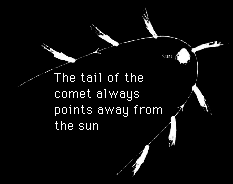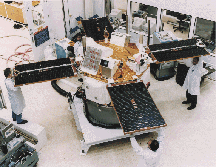The constellation Leo (The Lion)
Click on image for full size
1998 Leonids Meteor Shower
News story originally written on November 7, 1998
The Leonids meteor shower is expected to reach its peak intensity during
this year and next year on November 17/18th. The best show will be seen
this year in Asia and next year in Europe and Asia. During both years any
place in the northern hemisphere will see a larger-than-normal display.
The meteors in the Leonids shower are pieces of the
comet Temple-Tuttle. The comet's orbit
brings it near the sun every 33 years. When it approaches
perihelion pieces of it break off
and spread out through the comet's orbit. We see the pieces of the comet
as a meteor shower when the Earth passes through the comet's orbit, as it
will on November 17th.
The name "Leonids" comes from the constellation
Leo. The meteors
appear to orginate from a point in the constellation. This point is
called the radiant because the meteors seems to radiate from it.
The best time to view the meteor shower is in the early morning of the
17th/18th local time. The intensity will increase during the night and
will be most intense just before dawn.
You might also be interested in:

When comets are kicked out of the Oort Cloud, they begin a passage into the solar system, spinning and tumbling as they come. The trajectory which they acquire can be hyperbolic, parabolic, or elliptic
...more
The Leonids meteor shower is expected to peak on November 17th, 1998. The meteors may cause problems with many different satellites in orbit. The meteors could break the outside skin of the satellites
...more
It was another exciting and frustrating year for the space science program. It seemed that every step forward led to one backwards. Either way, NASA led the way to a great century of discovery. Unfortunately,
...more
The Space Shuttle Discovery lifted off from Kennedy Space Center on October 29th at 2:19 p.m. EST. The weather was great as Discovery took 8 1/2 minutes to reach orbit. This was the United States' 123rd
...more
A moon was discovered orbiting the asteroid, Eugenia. This is only the second time in history that a satellite has been seen circling an asteroid. A special mirror allowed scientists to find the moon
...more
Will Russia ever put the service module for the International Space Station in space? NASA officials want an answer from the Russian government. The necessary service module is currently waiting to be
...more
A coronal mass ejection (CME) happened on the Sun early last month. The material that was thrown out from this explosion passed the ACE spacecraft. The SWICS instrument on ACE has produced a new and very
...more









